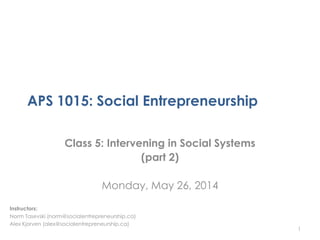APS1015 Class 5 - Intervening in Systems Part 2
- 1. APS 1015: Social Entrepreneurship Class 5: Intervening in Social Systems (part 2) Monday, May 26, 2014 1 Instructors: Norm Tasevski (norm@socialentrepreneurship.ca) Alex Kjorven (alex@socialentrepreneurship.ca)
- 2. ┬® Norm Tasevski Agenda ŌĆó Recap of Empathy Mapping & Business Modelling(last class) ŌĆó Building an Intervention ŌĆō Step 3: Financial Modeling ŌĆō Step 4: Target Setting ŌĆó Prep for Monday 2
- 3. ┬® Norm Tasevski Intervening ŌĆō A 4 Step Process 3 Step 1: Empathy Mapping Step 2: Business Modeling Step 3: Financial Modelling Step 4: Target Setting
- 4. ┬® Norm Tasevski ŌĆó For our purposes, this is a process for determining whether business model generates a viable margin ŌĆó Who determines viability? ŌĆó The Steps: ŌĆō Assess revenue model (# units, unit price) ŌĆō Assess expense model (fixed, variable) ŌĆō Generate margin 4 Financial Modeling
- 5. ┬® Norm Tasevski ŌĆó Step 1: Assess Revenue Model ŌĆō 2 parts: # units sold and price/unit ŌĆō How do we define a ŌĆ£unitŌĆØ? ŌĆó The value proposition perceived as having value by the customer, and to which the customer is willing to pay a price ŌĆō The relationship between units and price: ŌĆó The more ŌĆ£customŌĆØ a unit, the fewer that can be offered and the costlier the unit is to make. The product is perceived as more valuable, and therefore price is higher ŌĆó The more ŌĆ£commoditizedŌĆØ a unit, the more that can be offered and the cheaper the unit is to make. The product is perceived as less valuable, and therefore price is lower ŌĆō How do we determine price? ŌĆó This isŌĆ”complicated 5 Financial Modeling
- 6. ┬® Norm Tasevski Financial Modeling ŌĆō Determining Price 6 Determine cost + desired margin (see step 2) Ask people!!! (friends, potential customers, etc)
- 7. ┬® Norm Tasevski ŌĆó Step 2: Determine Cost Model ŌĆō 2 parts: fixed costs, variable costs ŌĆó Fixed: ŌĆō The costs that donŌĆÖt change as more units are sold ŌĆō Example: rent ŌĆō Goal: determine the total fixed costs incurred ŌĆó Variable: ŌĆō The costs that do change as more units are sold ŌĆō Example: raw materials used to build the product ŌĆō Goal: determine the per unit fixed costs incurred ŌĆó A note: all fixed costs are variable over time! 7 Financial Modeling
- 8. ┬® Norm Tasevski 8 Your Best FriendŌĆ”
- 9. Break 9
- 10. ┬® Norm Tasevski ŌĆó The key business and social metrics used to execute the business model in a way that aligns with the financial model ŌĆó Business targets: ŌĆō Revenue targets (e.g. # units sold in the quarter) ŌĆō Expense targets (e.g. target marketing budget) ŌĆó Social targets: ŌĆō ŌĆ£OutputŌĆØ targets (e.g. # people employed) ŌĆō ŌĆ£OutcomeŌĆØ targets (e.g. increase in community resiliency) ŌĆó SMART 10 Target Setting
- 11. ┬® Norm Tasevski ŌĆó Baseline vs. Target ŌĆō Baseline: your starting point ŌĆō the reference metrics ŌĆō Target: the measurable improvement from the baseline ŌĆó Linking targets to the business model ŌĆō Each element of the canvas deserves their own metrics (e.g. target # customers, target #/type of activities to run) 11 Target Setting
- 12. ┬® Norm Tasevski What did we learn? 12
Editor's Notes
- #13: NORMFocus on the distinction between entrepreneur and enterprise











